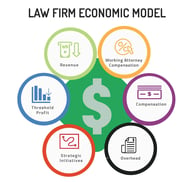Every business deals with overhead costs, but in law firms, it can actually be assigned to individual attorneys as an expense in their profit calculation. Profit, as you know, is revenue minus expenses. Revenue can be associated with individual attorneys, whether through billable hours, contingency fees, or other originations.
But, how can you fairly attribute expenses like rent or postage to each person on the team?
Our Approach
In this article, we aim to provide a general approach, explaining our thought process without covering every possible scenario, due to time constraints. Our goal is to get you started with calculating your own overhead - or possibly to inspire you to rethink how you already calculate overhead.
We break down the process of calculating overhead into 3 steps. Feel free to focus on the sections most relevant to you.
|
STEP 1: Gather Information STEP 2: Refine Expenses STEP 3: Allocate Overhead |
STEP 1: Gather Information |
This step is simple at first, but depending on the kinds of expenses your firm has and how you organize them, it could become complicated.
What Is Your Data Source?
Your firm needs to have a reliable and accessible means of recording revenue and expenses. Quickbooks is often recommended if you don’t already have a solution.
What Time Period to Use?
When calculating overhead, it’s common to handle one year at a time. You have a few options, but the goal is to use recent, accurate, consistent, and complete data.
We will use some examples based on the assumption that you are reading this article in the fall of 2023.
- Use 2023 year-to-date expense data and annualize. (Divide the total expenses by the number of months that have passed and then multiply by 12.)
- Use the previous calendar year: If it is now 2023, use January through December of 2022.
- Use expense data from the last 12 months. If your books are completed through October 31, 2023, use expense data from 11/01/2022 through 10/31/2023.
Who Are Your People?
You will need to identify the attorneys, paralegals, and other timekeepers for whom you plan to attribute overhead. Note their hire date and term dates. (We do not attribute overhead costs for days the person was not employed with your firm.) We will use this later.
Whom to Exclude?
Typically, overhead is assigned to anyone who brings revenue into the firm. For support staff with low billable hours, it might make sense to consider their payroll as overhead expenses rather than calculating their profitability.
Example ScenarioIf you have a legal assistant who only bills $3k annually, you may wish to ask yourself what you would do with the results of the profit calculation. If this is a full-time employee, it is not likely that the $3k in revenue is enough to cover his payroll cost, so the profit calculation will inevitably come out negative. This of course is not a direct indicator that the employee is doing something wrong, because in many cases, legal assistants and law clerks are contributing to the firm in ways that are not always billable to a client. This is why we view that employee as an overhead expense rather than an “unprofitable employee,” and this is also why it is not always useful to us to calculate the profitability of support staff. |
Whom to Include?
All of that being said, for the purposes of allocating overhead, you may wish to select a list of employees for whom direct revenue performance is important. Roughly, if you have a clear hour or fee goal set for the employee as a core element of their job description, you probably want to calculate their profitability. (For example, “Timekeepers must bill 166 hours monthly.”) If that is the case, then they will receive an overhead allocation.
STEP 2. Refine Expenses |
How to Categorize Your Expenses?
If your income statement does not already categorize expenses, it is useful to take the time to do this. This helps with troubleshooting your overhead calculations and identifying deductions.
Expense Categories
- Payroll
-
Benefits (Includes Insurance and Employment Taxes)
-
Facility Costs (Like rent)
-
Equipment and Practice Aids
-
Practice Development
-
General and Admin Costs (Includes a wide variety of expenses, like bank fees and outsourced services.)
- Client Costs
-
Partner/Shareholder Income & Other Incomes (Includes Shareholder/Equity Partner payroll, if this is something you include in your income statement. Many firms do, and many firms do not.)
Indirect vs. Direct Overhead
“Indirect overhead” is what people usually mean when they say “overhead.” It’s everything the firm does to continue being a firm, whether that means keeping the lights on or paying malpractice insurance. It is in everyone’s best interest to do their part in paying for its upkeep. Thus we have indirect overhead.
Direct overhead is a little more straightforward, and it refers to expenses that are incurred by one specific attorney in satisfaction of his/her personal business decisions or needs. In this category, we might include a costly solo business trip or a personal assistant. This is less common but it does happen. Due to the nature of these expenses, we usually see them attributed to shareholders, if at all.
What to Include In Indirect Overhead Expenses?
Consider resources the firm pays for that benefit attorneys indirectly. This may include office space, property tax, and payroll for billing departments.
What to Deduct from Indirect Overhead Expenses?
We typically use all of the above-listed Expense Categories in determining the total indirect overhead but deduct the following since they will already be subtracted as an expense during the profit equation:
Payroll and Benefits (for timekeepers) and
Partner/Shareholder Income & Other Incomes.
It would not make sense to subtract someone’s payroll twice. Also, payroll is more of a direct expense.
Similarly, we do not include Shareholder compensation in the total indirect overhead because:
- Shareholder compensation is irrelevant to calculating individual timekeeper profitability, which is intended to be a measure of timekeepers’ own performance (in other words, employees of the firm should not be responsible for the owners’ compensation), and
- Shareholder compensation is usually considered after the firm turns a profit, not before.
How to Treat Secretarial Overhead & Other Direct Expenses
In cases where legal assistants work with specific attorneys, allocate a portion of their payroll to those attorneys.
Example ScenarioLet’s say your firm has a few legal assistants who only report to one or two specific attorneys. For example, Richard the legal assistant reports to only Jessica and Marilyn the attorneys. If Richard’s total payroll expense is $50k, then it is logical to tack on $25k to each attorney’s overhead on top of whatever her general overhead is. So if Jessica’s general overhead was $60k and her secretarial overhead allocation for Richard is $25k, then Jessica’s total overhead responsibility is $85k. Naturally, with Jessica and Marilyn covering Richard’s payroll expense, it is best to subtract Richard’s $50k in payroll from the general overhead expenses applied to the rest of the firm. This is not a very common scenario, but it does happen and it is useful to know how to treat it. The example with Jessica, Richard, and Marilyn was used to explain secretarial overhead, but the same logic could apply if Marilyn went on a $25k business trip that did not involve any other attorneys at the firm. That $25k is applied only to Marilyn, on top of whatever her general overhead allocation is. |
Summary of
Step 1 & Step 2
Are you with us so far? Here is a summary list. At this point, you should have identified your firm’s total expenses, and you have probably subtracted timekeeper payroll and benefits.
- List everyone who gets overhead allocations and their hire and term dates. Leave out employees who do not bring in legal fees.
- Obtain total firm expenses.
- Subtract timekeeper payroll and benefits (unless the timekeeper is a legal assistant, paralegal, or law clerk who bills very little and whose personal profitability is not relevant).
- Subtract direct overhead allocations (to be attributed later to specific attorneys)
- What’s left over is the Overhead to Allocate.
STEP 3: Allocate Overhead to People |
Whew! A lot has happened between the beginning of this article and now, but you are almost finished.
The next part can be broken into 4 sections.
Section 1: Calculate FTEs (Full-Time Equivalency)
Consider how long employees have been with your firm during the specific time period. “FTE” means Full-Time Equivalency and it is the proportion of the current time period for which the employee was active at your firm.
|
FTE Example Scenario If you are calculating overhead for the calendar year of 2022, and Robert only started working with you on July 1 and stayed through December, then his “FTE” count is 0.5. (Why do we say “proportion?” For example, if for some reason the time period you are treating is not a full year but just July through December 2022, then Robert’s FTE becomes 1.0. If the time period is January through June 2022, then Robert’s FTE is 0.0. As you can see, FTE depends on both (1) the dates that the employee was active and (2) the time period you are looking at.) |
|
An FTE “Hard” Example Scenario Let’s look at a “difficult” scenario, because this happens all the time with the current state of turnover at law firms, and it will inevitably come up for you. Let’s say you are calculating overhead for 2022, Jennifer was hired on February 25, and she left the firm on November 3. First, you will find total the number of days that Jennifer was present. Visit this handy date duration calculator to make this easier: https://www.timeanddate.com/date/duration.html. Enter her start date and her end date and it will provide the total number of days: 252. Because you are treating a full year, that’s 365 days. Divide 252 by 365 and you are done: 0.69. |
Categorize and Subtotal: After calculating all FTEs, categorize employees. The categories are typically: shareholders/equity partners, non-equity partners, associates, of counsel, and paralegals - or whatever categories you have at your firm. Then, add up all of the FTEs in each employee category. Each category gets its own subtotal for FTEs.
FTE %: Then, calculate the percentage that each employee represents in his or her own category.
|
FTE % Example: In the below example, we add 0.5 to 1.19 to get the total FTE count for the category. Then we calculate FTE % for Robert by dividing 0.5 by 1.19 = 42%. If the FTE percentages in a single category do not add up to 100%, check your work.
|
Section 2: Assign Weights to Employee Categories
You may choose to skip this step, but we recommend doing this step. The logic is that lower employee levels should only be responsible for so much of the overhead, due to limitations in their earning potential, such as billing rates and level of experience. Profitability should be calculated proportionately to an employee’s ranking. Therefore we recommend weighting each category. We usually use the following weights:
|
Category |
Weight |
|
Equity Partners / Shareholders |
1.00 |
|
Non-Equity Partners |
1.00 |
|
Associates |
0.75 |
|
Of Counsel |
0.50 |
|
Paralegals / Legal Assistants |
0.25 |
Section 3: Determine the Overall Percentage For Each Employee Category
Calculate the percentage each employee category represents.
Now that we have the FTE subtotals and the assigned weights for each category, we can:
- Multiply FTE subtotals and assigned weights together to find a new number called Weight Associated to Category,
- Use this Weight Associated to Category to calculate the percent that each category represents out of the total Weight Associated to Category,
- Then, the percentage for each category is the percentage of the total overhead that that category receives. This is called Overhead Assigned to Category.
|
Example: Calculating Percentage For Each Employee Category Suppose that the total Overhead to Allocate is $500,000.
*Cross-checking: If the percentages in the % Applied to Category do not add up to 100%, or if the Overhead Assigned to Category amounts do not add up to your total Overhead to Allocate, check your work. |
Section 4: Distribute the Overhead Assigned to Category
This is the last step! Do you remember when we asked you to calculate the percentage that each employee represents in his or her own category in Section 1, “FTE % Example”?
|
Example of Overhead Allocation Based on FTEs In the aforementioned “FTE % Example,” Robert had 42% and Jennifer had 58% of the total FTE for their employee category. Let’s say Robert and Jennifer are the two legal assistants shown in the above table, fifth row. The legal assistants’ Overhead Assigned to the Category was $35,000. It is highlighted above in the far right column.
Continuing that example:
We calculate Jennifer’s Overhead Allocation by finding 58% of $35,000 = $20,300. |
End Result
After you perform this calculation for each individual in your firm, you are finished. Just like the above table “Legal Assistants, 2022,” you should have one table for each employee category. In each table, list their names next to their overhead allocations for that year (or whatever time period you chose to work with).
At this point, you can go ahead and add in whatever direct overhead is appropriate for individual attorneys, where applicable.
You can also review your results and begin to consider whether the overhead expenses are appropriate for a firm of your size.
Profitability, Anyone?
Finally, if you do plan to calculate profitability, you can perform the following calculation for an individual timekeeper.
PROFITABILITY CALCULATION |
|
Fees Collected ( minus) Payroll (including Bonus) Benefits Indirect Overhead . Direct Overhead . Secretarial Overhead Profit |
Exploring Profitability Results
If you are finding that some timekeepers are unprofitable, in general terms, it may be because:
(1) They are not producing enough revenue, which could be due to insufficient workload, low realization rates, or inadequate billing rates.
(2) Costs are too high, including payroll, benefits, overhead, or a combination of these.
Check Out Our Overhead Calculator
We also have an overhead calculator template among our website resources which may be handy for you. It uses the same steps described in this article. Overhead calculator Link
Congratulations, you are done! We hope this article was useful to you.
Recap of Overhead Calculation |
|
Below you will find a bird’s-eye view of the steps we just covered, for future reference.
|
Other helpful resources:
|
|
Divvying Up the Fee Dollar: Building a Law Firm Economic Model |
|
|
eBook: Building an Economic Model for Your Law Firm |
 |
Strategically Setting Billing Rates |
.webp?width=124&height=108&name=PerformLaw_Logo_Experts3%20(1).webp)



